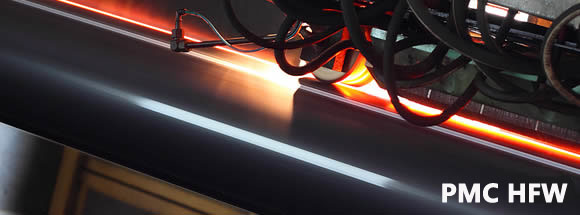
Welding Principle of ERW Steel Pipe
Basic principles of high frequency welding
The so-called high frequency is relative to the frequency of the alternating current of 50Hz, and generally refers to the high frequency current of 50KHz~400KHz. When high-frequency current passes through a metal conductor, two peculiar effects are produced: skin effect and proximity effect. High-frequency welding uses these two effects to weld steel pipes. So, what are these two effects?

Skin effect:
Refers to when a certain frequency of alternating current passes through the same conductor, the density of the current is not evenly distributed across all sections of the conductor, it will mainly concentrate on the surface of the conductor, that is, the density of the current on the surface of the conductor is high, and the density inside the conductor Small, so we vividly call it: "skin effect". The skin effect is usually measured by the penetration depth of the current. The smaller the penetration depth, the more significant the skin effect. This penetration depth is proportional to the square root of the resistivity of the conductor, and inversely proportional to the square root of frequency and permeability. In layman's terms, the higher the frequency, the more current is concentrated on the surface of the steel plate; the lower the frequency, the more scattered the surface current. It must be noted that although steel is a conductor, its magnetic permeability will decrease as the temperature rises. That is to say, when the temperature of the steel plate increases, the magnetic permeability will decrease and the skin effect will decrease.
Proximity effect:
Refers to when high-frequency current flows in opposite directions between two adjacent conductors, the current will flow intensively to the edges of the two conductors. Even if the two conductors have another shorter side, the current does not follow the shorter side. Route flow, we call this effect: "proximity effect". The proximity effect is essentially due to the role of inductive reactance, which plays a leading role in high-frequency currents. The proximity effect increases as the frequency increases and the distance between adjacent conductors becomes closer. If a magnetic core is added around the adjacent conductor, the high-frequency current will be more concentrated on the surface of the workpiece.
These two effects are the basis for realizing high-frequency metal welding. High-frequency welding uses the skin effect to concentrate the energy of the high-frequency current on the surface of the workpiece and uses the proximity effect to control the location and range of the high-frequency current flow path. The speed of the current is very fast, it can heat and melt the edges of adjacent steel plates in a short time, and realize the butt joint through extrusion.
Tips: ASTM A53 Grade B is more popular than other grades. These pipes can be bare pipes without any coating, or it may be Hot-Dipped or Zinc-Coated and manufactured by Welding or by a Seamless manufacturing process. In Oil and Gas, A53 grade pipes are used in the structural and non-critical applications.


